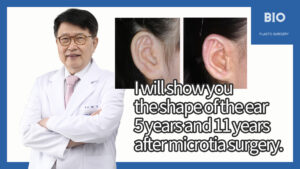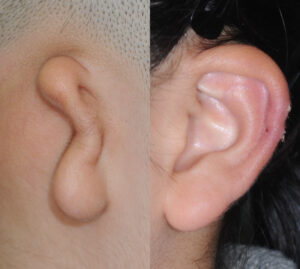Summary Background: This study describes the author’s experience with long-term follow-up analysis of secondary procedures in patients with unsatisfactory initial microtia reconstruction.
Methods: A total of 134 patients who underwent secondary operations between 1992 and 2021 were reviewed by examining medical records and photographic data. A total of 110 patients followed between 6 months and 26 years (average 33.2 months) were included for evaluation of aesthetic outcomes.
Results: Primary reconstruction was performed with costal cartilage in 113 patients, porous polyethylene implant in 7 patients, silicone implant in 6 patients, and others in 8 patients. The major external features at the time of the secondary reconstruction were lump (91 cases), deficient convolution (19 cases), and no framework with scarred mastoid skin (22 cases). All secondary reconstructions were performed with an autogenous costal cartilage framework. The framework was covered using temporoparietal fascia flap techniques in 118 patients, mastoid skin coverage technique in 12 patients, and others in 4 patients. One major complication (exposure of cartilage framework due to partial necrosis of fascial flap) and three minor complications (loss of moderate-sized full-thickness skin, grafted on the fascia) were recorded. The average score given for aesthetic outcomes, rated on a four-point Likert scale (i.e., 1 = poor, 2 = fair, 3 = good, and 4 = excellent) was 3.17 (median 3.00). A total of 42% of the patients were rated excellent and 36% were rated good.
© 2023 British Association of Plastic, Reconstructive and Aesthetic Surgeons. Published by Elsevier
Ltd. All rights reserved.


A 28-year-old female was shown after a multiple-stage autogenous costal cartilage construction at the age of 7. The reconstructed ear remained as an anteriorly rotated lump. The cartilage lump was replaced with a well-convoluted framework, which was covered using a contralateral temporoparietal fascia free flap. (B, C) Views of both ears 4 years after the operation. The score of the surgeon’s aesthetic outcome was 4.

![You are currently viewing Total rebuilding of the ear after unsatisfactoryinitial microtia reconstruction: 30-yearexperience using autogenous costal cartilageframework [Chul Park]](https://earsurgerykorea.com/wp-content/uploads/2023/10/2-3.jpg)



